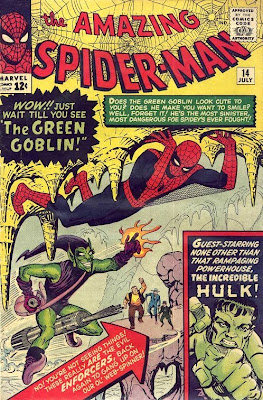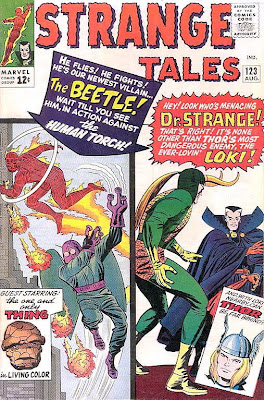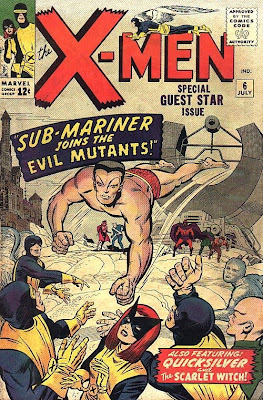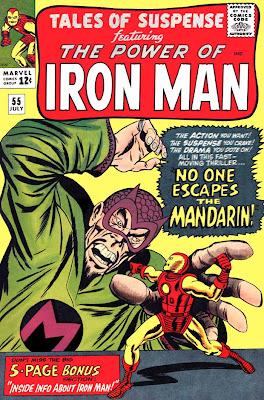
FANTASTIC FOUR #28
Two of the FF's old enemies--the Puppet Master and the Mad Thinker--team up to get revenge on our heroes. Thinker figures out the exact amount of radioactive clay Puppet Master needs to make a puppet of Professor X and gain control over him. Then Professor X is forced to order the X-Men to attack the Fantastic Four.
Nowadays, the X-Men are so perpetually popular its easy to forget there was a time when they were second-tier characters in the Marvel Universe. But
The X-Men was never that big a seller in the 1960s. Cross-overs like this (or like the Human Torch/Iceman team-up in
Strange Tales a few issues back) are quite obviously meant to generate interest in the X-Men's own book.
And that's just fine, as long at the story is good. And this one is good. Within the context of a comic book universe, the Thinker's plan makes sense. And, as usual, the action sequences are marvelous. There's a half-page panel near the end of the story, when all the heroes have figured out what the heck is going on, that features them going up against the Thinker's Awesome Android. That one panel alone would have been worth the price of the book. An earlier scene in which Iceman encases Ben's head in a big blog of ice--then adds a couple of blocks of ice to Ben's feet--is also pretty cool to look at.
There's an interesting and harmless mistake near the beginning of the story. Reed and Sue are reading a newspaper account of the X-Men's activities and Sue reads off a list of their opponents. She includes "the Space Phantom" on the list. But the Phantom had fought the Avengers, not the X-Men. Oh, well, poor Stan Lee was juggling so many characters at this point that I think we can forgive him if he loses track of a few details.

SPIDER MAN #14
Another strong issue introduces us to the Green Goblin--perhaps Spidey's greatest foe and certainly one of the most visually striking.
Gobby plans to create his own crime syndicate and figures taking out Spider Man is a good way to start. He recruits the Enforcers (the webslinger fought them in issue #10) to help, then lures Spider Man out to the Southwestern desert to ambush him.
-
-
His plan is a little hokey--he talks a movie producer into signing up Spider Man to star in a movie in order to lure the hero to the ambush site. It's a little contrived and conveniently ignores the fact that Peter knows from his previous showbiz experience that he can't get legally paid without giving up his secret identity. It also seems unnecessarily complicated--why is the desert a better location for an ambush than a back alley in New York? But what follows is so much fun that this is forgiveable. Besides, Stan Lee has a good reason for moving the action out to the Southwest.
-
-
Goblin and the Enforcers have a running battle with Spider Man that eventually takes them into a large system of inter-connecting caves. In the caves, they run into the Hulk, who just happens to be hiding out there. The Hulk, of course, decides to smash everyone.
-
-
It all ends with the Enforcers captured. The Hulk vanishes back into the caves and the Goblin escapes. The movie is cancelled and Peter has to take the bus back home.
-
-
In just a few more months, the Hulk will be given his own series again (he'll be sharing Tales to Astonish with Giant Man and the Wasp). So obviously, Stan Lee wants to give him some play in one of the more popular books--which explains Goblin's odd plan to lure Spider Man to the Southwest. It's not quite as satisfying as the X-Men/FF crossover, though. Hulk just kinda shows up without a strong plot-driven reason for being there. But, as I said above, the issue is so much fun in the end, it's easy to forgive the contrivences. A bit where Spider Man gets fed up and lays a nasty punch on the Hulk--only to hurt his hand without bothering the Hulk at all--is a wonderful moment.
-
-
Several details to take note of: The Green Goblin's true identity is kept a secret--in fact, Lee and Ditko themselves hadn't decided who he'd turn out to be. If I remember correctly, it's a disagreement on who the Goblin should be a few years down the road that causes Ditko to leave the book.
-
-
Also, there's some good characterization stuff among the supporting characters. Liz Allen continues to grow more attracted to Peter, which annoys Flash Thompson and causes Betty Brant to experience pangs of jealousy.
-
-
Finally, though the "let's make a movie" part of the plot is a little too silly, there's one character--a parody of the arrogant but clueless producer stereotype--who actually is pretty funny.
-

STRANGE TALES #122
The three thugs temporarily given super powers by Doctor Doom in FF #22 are back. Doom had stashed them away in another dimension, but we now find out they reappeared on Earth when Doom himself was hurled into Outer Space. Wanting to impress Doom should the master criminal ever return, they decide to take out the Fantastic Four one by one.
-
-
They start with Johnny, using asbestos robe to hog-tie him. Johnny manages to get loose, though, and eventually bring the trio to ground.
-
-
The Human Torch stories were never more than pretty good--but they were consistenly successful in one area. Johnny was always ending up in situations where he had to use his brains as well as his powers to win. This gave a little bit of bite to what were otherwise average (and sometimes mediocre) stories.
-
-
Dr. Strange, in the meantime, takes a nap at the wrong moment and gets captured by Nightmare. Like Johnny, he also must use his brains as well as his powers to escape. The story's main selling point, though, is Ditko's art. Anytime a Dr. Strange story gave Ditko a chance to portray both alien landscapes and bizarre monsters, it was bound to be worthwhile.
That's it for now. Next week, we'll see what Thor, Iron Man and Giant Man are up to.























